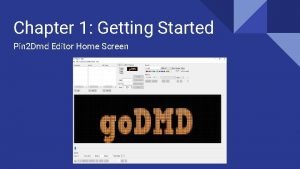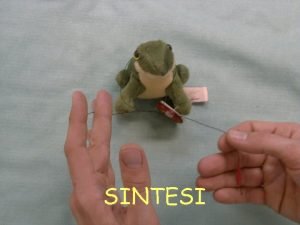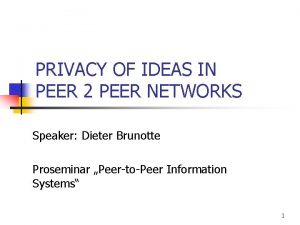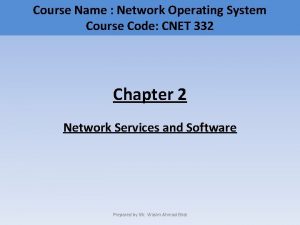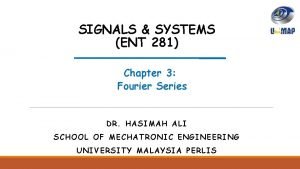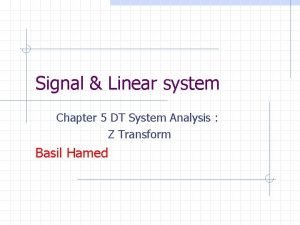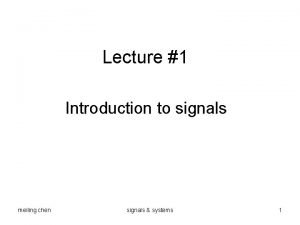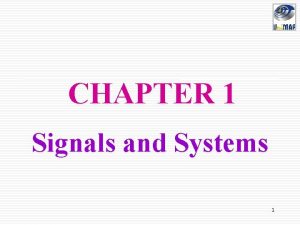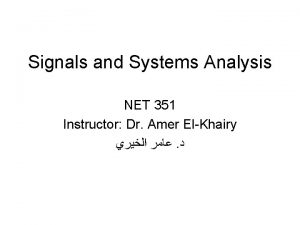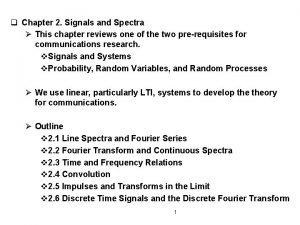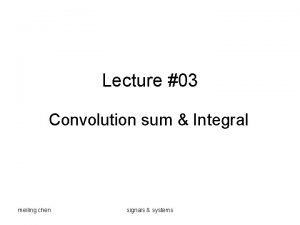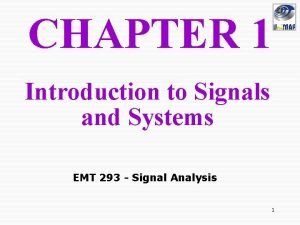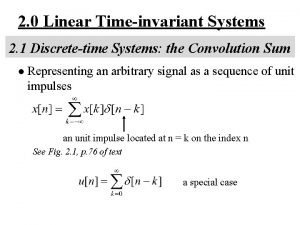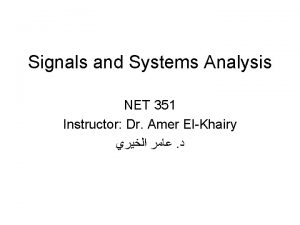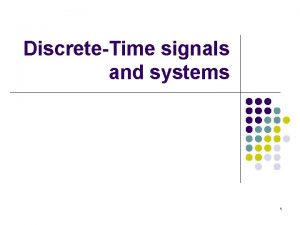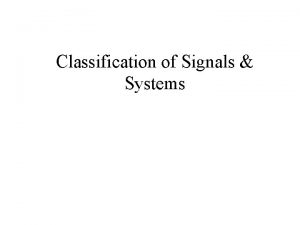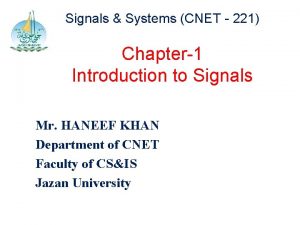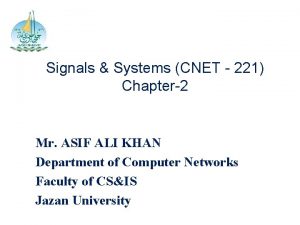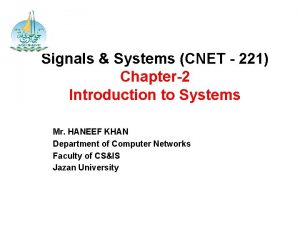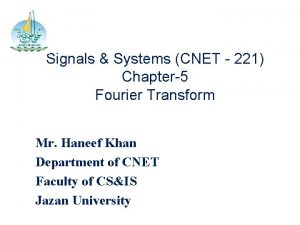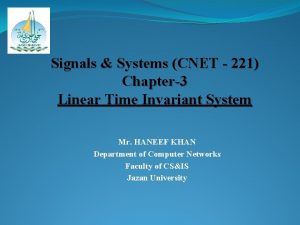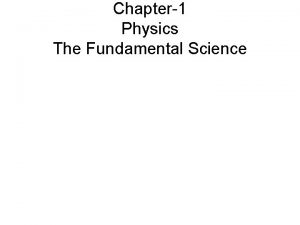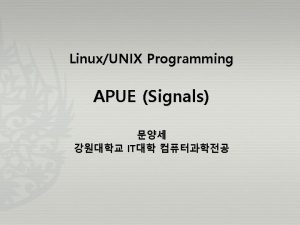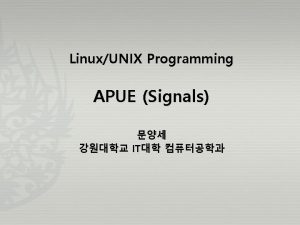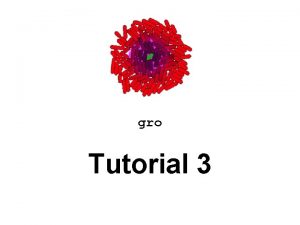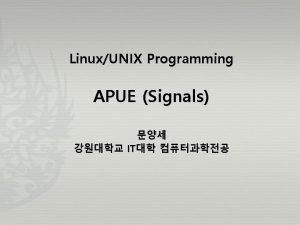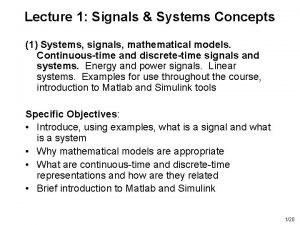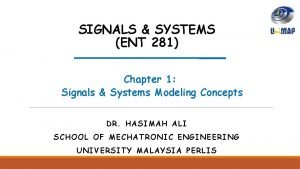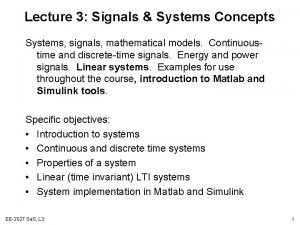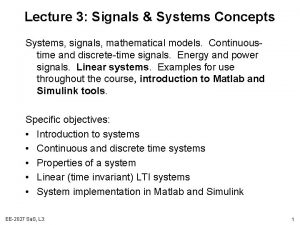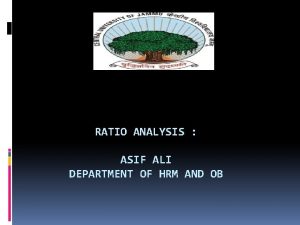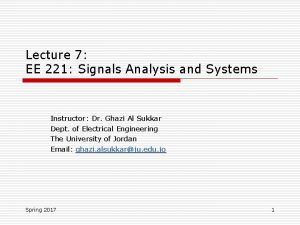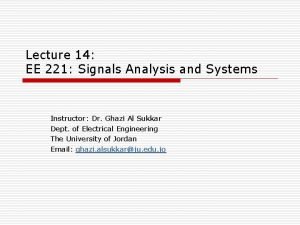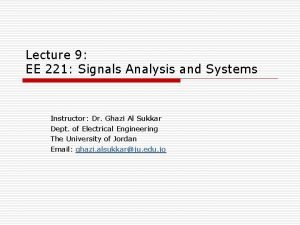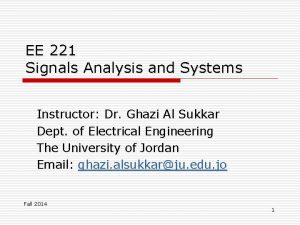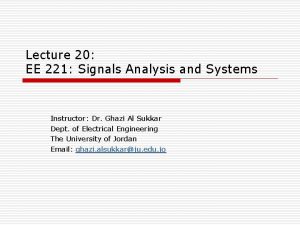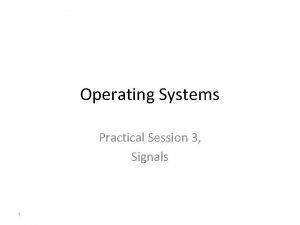Signals Systems CNET 221 Chapter1 Mr ASIF ALI





























- Slides: 29

Signals & Systems (CNET - 221) Chapter-1 Mr. ASIF ALI KHAN Department of Computer Networks Faculty of CS&IS Jazan University

Text Book & Online Reference Ø Textbook: A. V. Oppenheim and R. W. Schafer, Digital Signal Processing, Prentice-hall Ø E-Learning: http: //nptel. ac. in/courses/ind ex. php? subject. Id=11710407 4 Ø General Reference: http: //web. cecs. pdx. edu/ ~ece 2 xx/ECE 222/Slides/

Chapter Objective Following are the objectives of Chapter-I Ø Signal Definition, Classification, Representation of different signals including both Continuous and Discrete Ø Transformation of the independent variables Ø Signals Basic operation including Signals addition, subtraction and Multiplication

Course Description-Chapter-1 Introduction to Signals 1. 1 1. 2 1. 3 1. 4 1. 5 Introduction to Signals Continuous-Time & Discrete-Time Signals 1. 2. l Examples and Mathematical Representation 1. 2. 2 Signals Energy and Power Transformations of the Independent Variable l. 3. 1 Time Shifting 1. 3. 2 Time Reversal l. 3. 3 Time Scaling 1. 3. 4 Periodic and Aperiodic Signals l. 3. 5 Even(Symmetric) and Odd(Anti-symmetric) Signals Exponential and Sinusoidal Signals Unit Impulse and Unit Step Function

Introduction to Signals What is Signal? SIGNAL is a function or set of information or data representing a physical quantity that varies with time, space or any other independent variable, usually time. Examples: Ø Voltage/Current in a Circuit Ø Speech/Music Ø Any company’s industrial average Ø Force exerted on a shock absorber Ø A*Sin(ῳt+φ)

Introduction to Signals(Continued…. . ) Example of various signals(Graphs) :

Introduction to Signals(Continued…. . ) Measuring Signals

Classifications of Signals are classified into the following categories: Ø Continuous-Time Signals Ø Discrete-Time Signals Ø Even and Odd Signals Ø Periodic and Non-Periodic (aperiodic) Signals Ø Energy and Power Signals :

Continuous Time and Discrete Time Signals A signal is said to be continuous when it is defined for all instants of time. Example: Video, Audio A signal is said to be discrete when it is defined at only discrete instants of time Example: Stock Market, Temperature :

Even and Odd Signals A signal is said to be even when it satisfies the condition X(t) = X(-t) ; X[n] = X[-n] A signal is said to be odd when it satisfies the condition X(-t) = -X(t) ; X[-n] = -X[n] :

Periodic and Non-periodic (Aperiodic) Signals A signal is said to be periodic if it satisfies the condition x(t) = x(t + T) or x(n) = x(n + N) for all t or n Where T = fundamental time period, 1/T = fundamental frequency. :

Energy and Power Signals A signal is said to be energy signal when it has finite energy. or A signal is said to be power signal when it has finite power. or NOTE: A signal cannot be both, energy and power simultaneously. Also, a signal may be neither energy nor power signal. Power of energy signal = 0 & Energy of power signal = ∞ :

Signals Basics Operation Example-1: For the given signals x 1(t) and x 2(t) plot the Signal z 1(t) = x 1(t) + x 2(t) Answer: As seen from the diagram above, • -10 < t < -3 amplitude of z(t) = x 1(t) + x 2(t) = 0 + 2 = 2 • -3 < t < 3 amplitude of z(t) = x 1(t) + x 2(t) = 1 + 2 = 3 • 3 < t < 10 amplitude of z(t) = x 1(t) + x 2(t) = 0 + 2 = 2

Signals Basics Operation (Continued……. . ) Example-2: For the given signals x 1(t) and x 2(t) plot the Signal z 1(t) = x 1(t) - x 2(t) Answer: As seen from the diagram above, • -10 < t < -3 amplitude of z (t) = x 1(t) - x 2(t) = 0 - 2 = -2 • -3 < t < 3 amplitude of z (t) = x 1(t) - x 2(t) = 1 - 2 = -1 • 3 < t < 10 amplitude of z (t) = x 1(t) + x 2(t) = 0 - 2 = -2

Signals Basics Operation (Continued……. . ) Example-3: For the given signals x 1(t) and x 2(t) plot the Signal z 1(t) = x 1(t) * x 2(t) Answer: • • As seen from the diagram above, -10 < t < -3 amplitude of z (t) = x 1(t) ×x 2(t) = 0 × 2 = 0 -3 < t < 3 amplitude of z (t) = x 1(t) ×x 2(t) = 1 × 2 = 2 3 < t < 10 amplitude of z (t) = x 1(t) × x 2(t) = 0 × 2 = 0

Transformations of the Independent Variable (Time Shifting ) x(t ± t 0) is time shifted version of the signal x(t). Ø x (t + t 0) →→ negative shift Ø x (t - t 0) →→ positive shift

Transformations of the Independent Variable (Time Scaling) x(At) is time scaled version of the signal x(t). where A is always positive. |A| > 1 →→ Compression of the signal |A| < 1 →→ Expansion of the signal Note: u(at) = u(t) time scaling is not applicable for unit step function.

Transformations of the Independent Variable (Time Reversal) x(-t) is the time reversal of the signal x(t).

Example: Time Scaling For the given signal X(t) shown in figure below, sketch each of the following signals. (a) Time scaled signal X(2 t). (b) Time shifted signal X(t+2). (c) X(t) + X(-t). Solution:

Example: Time Scaling For the given signal X(t) shown in Figure-6, sketch each of the following signals. a. Time reversed signal X(-t). b. Time scaled signal X(2 t). c. Time shifted signal X(t+2). d. { X(t) + X(-t) } e. { X(t) - X(-t) } Solution:

Exponential and Sinusoidal Signals

Exponential and Sinusoidal Signals(Continued…. . )

The Unit Step Function Definition: The unit step function, u(t), is defined as That is, u is a function of time t, and u has value zero when time is negative (before we flip the switch); and value one when time is positive (from when we flip the switch).

The Unit Step Function-Example Draw the waveform for the signal X(t) having the expression, X(t) = 2 * {u (t + 0. 5) – u (t – 0. 5)}. Answer

The Unit Impulse Function So unit impulse function is the derivative of the unit step function or unit step is the integral of the unit impulse function

Representation of Impulse Function The area under an impulse is called its strength or weight. It is represented graphically by a vertical arrow. An impulse with a strength of one is called a unit impulse.

Unit Impulse Properties

Example: The impulse Function

Videos 1. https: //www. youtube. com/watch? v=7 Z 3 LE 5 u. M 6 Y&list=PLb. MVog. Vj 5 n. JQQZbah 2 u. RZIRZ_9 kfoq. Zyx 2. Signals & Systems Tutorial https: //www. youtube. com/watch? v=y. Lez. P 5 ziz 0 U&list=PL 56 ED 47 DCECCD 69 B 2
 Of mice and men chapter1
Of mice and men chapter1 Burnished bronze feet
Burnished bronze feet Dmd chapter1
Dmd chapter1 Minahil asif
Minahil asif Ltad evreleri
Ltad evreleri Barrel chest
Barrel chest Amir asif
Amir asif O vicryl suture
O vicryl suture Asif international
Asif international Asif əsgərov
Asif əsgərov Communicative signals and informative signals
Communicative signals and informative signals Informative signals example
Informative signals example Communicative and informative signals
Communicative and informative signals Cnet3
Cnet3 Cnet syndication
Cnet syndication Cnet
Cnet Cnet communication
Cnet communication Cnet ftp
Cnet ftp Fourier series integral
Fourier series integral Signals and systems oppenheim solutions chapter 5
Signals and systems oppenheim solutions chapter 5 Precedence rule in signals and systems
Precedence rule in signals and systems Precedence rule in signals and systems
Precedence rule in signals and systems Convolution sum in signals and systems
Convolution sum in signals and systems Pulse train fourier transform
Pulse train fourier transform Convolution sum and convolution integral
Convolution sum and convolution integral Introduction to signals and systems
Introduction to signals and systems Convolution sum in signals and systems
Convolution sum in signals and systems Sinusoidal signal
Sinusoidal signal Signal and systems
Signal and systems Classification of signals and systems
Classification of signals and systems


